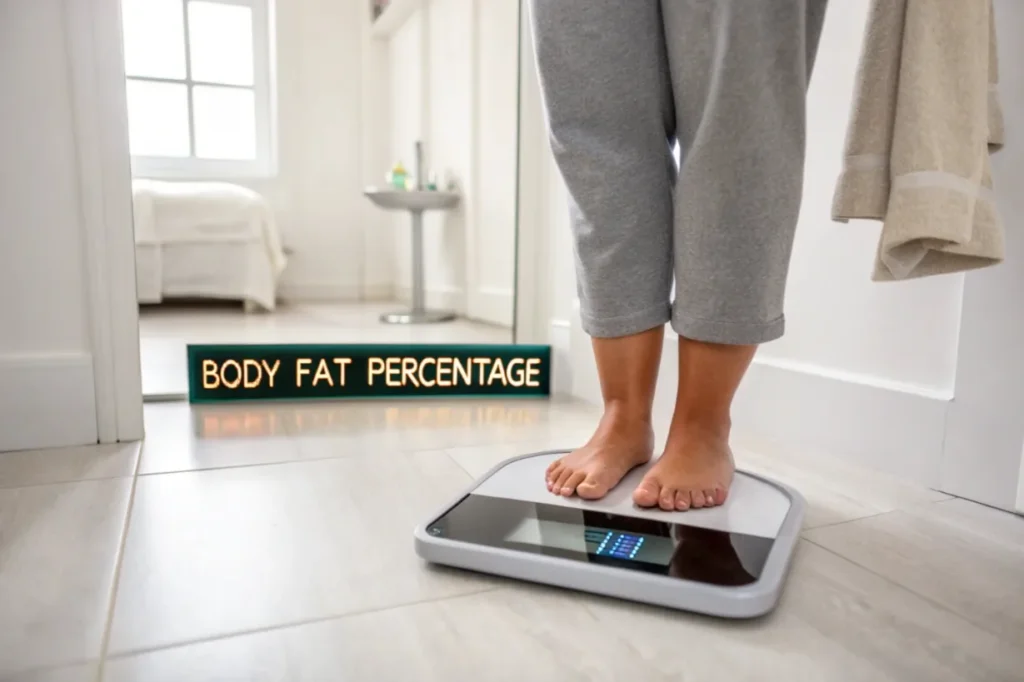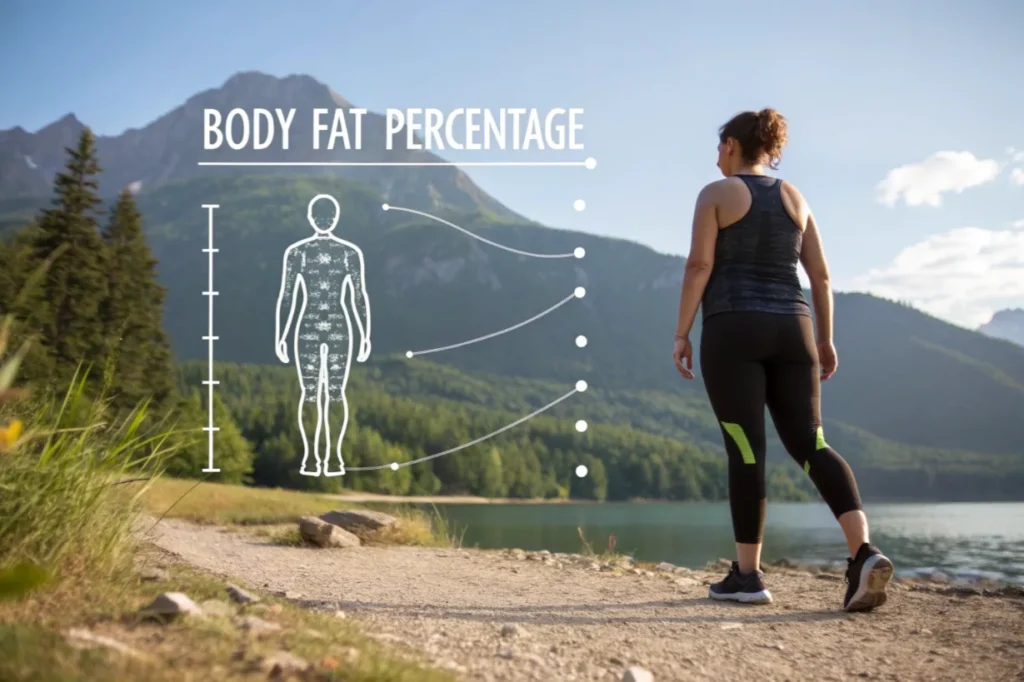Did you know? According to a 2026 study in the *Journal of Applied Physiology*, body fat percentage is three times more accurate than BMI for predicting long-term health risks. Despite this, 76% of people still rely on their bathroom scale for tracking fitness progress.
Whether you’re an athlete or aiming to improve health, knowing your body fat percentage is key. This guide offers insights on measuring, interpreting, and optimizing body fat for your goals.
Are you ready to begin a transformative journey? Let this innovative tool guide you toward a healthier, fitter you. Take control now and make your dream body a reality. Get ready to calculate, transform, and conquer!
Key Takeaways:
- Body fat percentage matters more than weight for health assessment
- Essential fat is crucial (2-5% men, 10-13% women)
- Multiple measurement methods available
- Both too high and too low body fat pose risks
- Regular monitoring helps track progress
- Healthy ranges vary by age and gender
Let’s dive into the science of body composition and discover how understanding your body fat percentage can transform your approach to health and fitness.
Calculate Your Body Fat
What is Body Fat, and Why is it Important?
Body fat isn’t just unwanted weight—it’s a crucial component of your body composition that serves several vital functions for health and energy. Understanding metabolic health is essential for maintaining optimal body fat levels and improving body composition.
Essential Functions of Body Fat:
- Energy storage and reserve
- Organ protection
- Hormone regulation
- Temperature maintenance
- Vitamin absorption
- Immune system support
Learn how body fat affects metabolism
Types of Body Fat

1. Essential Fat
- Minimum required for survival
- Found in bone marrow, organs, and muscles
- Men: 2-5%
- Women: 10-13%
2. Storage Fat
- Subcutaneous fat (under skin)
- Visceral fat (around organs)
- Gender-specific distribution patterns
Discover how fat distribution affects health
Comprehensive Body Fat Measurement Methods
1. DEXA Scan
- Gold standard accuracy (±1-2%)
- Measures bone density
- Provides detailed body composition
- More expensive option
2. Hydrostatic Weighing (Underwater Weighing)
- Highly accurate (±1.5-2%)
- Requires complete submersion
- Available at specialized facilities
3. Skinfold Calipers (Anthropometric Method)
- Affordable and accessible
- Requires trained professional
- Accuracy depends on technique
4. Bioelectrical Impedance Analysis (BIA)
- Convenient home testing
- Accuracy varies with hydration
- Good for tracking trends
Calculate your body fat percentage
Healthy Body Fat Ranges by Age and Gender
Men’s Healthy Body Fat Ranges:
| Age | Athletic | Healthy | Acceptable |
| 20-29 | 10-14% | 15-19% | 20-25% |
| 30-39 | 12-16% | 17-21% | 22-27% |
| 40-49 | 14-18% | 19-23% | 24-29% |
| 50+ | 16-20% | 21-25% | 26-31% |
Women’s Healthy Body Fat Ranges:
| Age | Athletic | Healthy | Acceptable |
| 20-29 | 18-22% | 23-27% | 28-32% |
| 30-39 | 20-24% | 25-29% | 30-34% |
| 40-49 | 22-26% | 27-31% | 32-36% |
| 50+ | 24-28% | 29-33% | 34-38% |
Learn more about optimal body composition
Health Risks of Improper Body Fat Levels

Risks of High Body Fat and Obesity
- Cardiovascular disease
- Type 2 diabetes
- Sleep apnea
- Joint problems
- Certain cancers
- Metabolic syndrome
Risks of Low Body Fat
- Hormonal imbalances
- Reproductive issues
- Weakened immune system
- Nutrient deficiencies
- Bone density loss
- Mental health impacts
Understand the connection between body fat and metabolism
Strategies for Maintaining Healthy Body Fat
1. Nutrition
- Follow a balanced nutrition plan
- Focus on whole foods
- Maintain proper macronutrient ratios
- Stay hydrated
2. Exercise
- Combine cardio and strength training
- Include HIIT workouts
- Maintain consistency
- Allow proper recovery
3. Lifestyle Factors
- Prioritize quality sleep
- Manage stress levels
- Stay active throughout the day
- Regular monitoring
FAQs About Body Fat Percentage
Q: How often should I measure my body fat?
A: Monthly measurements are typically sufficient for tracking progress.
Q: Which measurement method is most accurate?
A: DEXA scans provide the most accurate measurements, followed by hydrostatic weighing.
Q: Can I lose fat and gain muscle simultaneously?
A: Yes, through proper nutrition and training programs.
Sources:
- https://www.calculator.net/body-fat-calculator.html
- https://www.fatcalc.com/bf
- https://www.omnicalculator.com/health/body-fat
- https://www.medindia.net/patients/calculators/body-fat-calculator.asp
- https://www.fittr.com/tools/body-fat-calculator
- https://www.precisionnutrition.com/body-fat-calculator
- https://www.nasm.org/resources/body-fat-calculator
- https://www.size.ly/calculator/body-fat-percentage-calculator
- https://www.fitwatch.com/calculator/ideal-body-fat-weight
Conclusion
As we move through 2026, the science is clear: your body fat percentage is the true north star for health and fitness, far surpassing the outdated metric of body weight. This guide has illuminated why body composition matters—from the essential fat your body needs to function to the health risks associated with both extremes. Relying solely on a scale is a relic of the past; understanding and managing your body fat percentage is the future of personalized wellness.
Your next steps are clear. First, use the calculator provided to establish your personal baseline. Second, choose a consistent measurement method—whether calipers, a smart scale, or professional assessment—and schedule regular check-ins to monitor your progress. Finally, integrate this knowledge into your fitness and nutrition strategy, focusing on building lean muscle and maintaining a healthy fat range for your age and gender.
The journey to a healthier you begins with a single, informed calculation. Stop guessing and start knowing. Use the tool above now to calculate your body fat percentage and take the first definitive step toward mastering your body composition in 2026 and beyond.
Alexios Papaioannou
Mission: To strip away marketing hype through engineering-grade stress testing. Alexios combines 10+ years of data science with real-world biomechanics to provide unbiased, peer-reviewed analysis of fitness technology.
